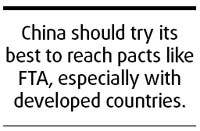Handled with tact, FTAs can do what WTO can't
By Qiao Xinsheng (China Daily)
Updated: 2008-04-18 07:31
Updated: 2008-04-18 07:31
On April 7, China and New Zealand signed a free trade agreement (FTA) covering trade in goods and services as well as investment, making it the first FTA reached by China with a developed country.
During his visit to China last week, Kevin Rudd, Australian Prime Minister, said that Australia and China would reopen their FTA negotiations soon.

After the 10th round of FTA negotiations between China and Australia ended in October last year, the two sides had not started the 11th round which was originally scheduled in the first half of 2008.
FTA is a bilateral protocol on the terms on which to promote free trade between the signing countries based upon their negotiations.
It became clear years ago that organizations promoting regional cooperation, like FTA, would take the place of the World Trade Organization (WTO) in global trade after the WTO faced huge pressures on its multilateral negotiations.
Now that more countries are seeking to reach FTAs with their trading partners, the WTO would no longer function as it did.
Compared with a multilateral organization like the WTO, FTAs are much more convenient in several aspects.
The bilateral negotiation is usually focused on the substantial interests of each partner without paying much attention to the ideological issues. When the negotiators have to worry only about the trade terms, there is a better chance that they will reach a consensus.
Such negotiations are also more flexible than the multilateral ones in many ways. Financial aids or increased trade volumes under the favorable trade terms are often added as a supplementary leverage to help reaching the FTAs.
On some other occasions, the two countries could reach agreements about trade ties, like free trade in goods or services, which could serve as a base point to transform the arrangements into full and formal FTAs in the future.
Besides, the FTA negotiations are usually founded upon geopolitical relationships, which rely heavily upon mutual trusts between the two countries.
The FTA reached by China and New Zealand is a fruit of practical, flexible and friendly negotiations. Thanks to a mature geopolitical relationship and supplementary economic structures to each other, China and New Zealand have been able to sign the agreement in a relatively short period.
New Zealand was the first country that signed a bilateral agreement with China about China's entry into the World Trade Organization. And it was the first developed country that recognized China's full market economy status.
The fact that New Zealand has signed the FTA with China as the first developed country suggests the importance that New Zealand attaches to its trade with China. And it has also displayed a positive approach in helping China integrate into the global economy as early as possible.
China should try its best to strengthen ties with its trade partners by reaching pacts like FTA, especially with developed countries.
However, trade negotiations are often subject to political changes. There have been precedents in which China paid a dear price to win an equal position with other trading powers. One has only to recall what happened during the negotiations for its WTO membership.
If China wants to establish more free trade zones with other countries, the Chinese negotiators should stick to several principles.
One of the most important targets for an FTA is to lower trade barriers or to eliminate trade restrictions between two countries.
Bearing that in mind, the negotiators should consider trade ties in all sectors as a whole. Not only should they fix the pact terms according to current trade volume and structure, but also consider the sectors that have remarkable potential to increase their trade volume in the future. The country's upcoming trade restructure should also be kept in mind.
The negotiators should also pay enough attention to foster the service trade of China. Being a huge market for the foreign service suppliers, China is also aiming at boosting its capability of offering services to its trade partners. Such a bright prospect of the growth in service trade would be a strong leverage for trade talks.
Another important task for the negotiators is to try and tap the international labor market for Chinese talents. One way of doing this is by arranging proper terms in the pacts to facilitate the Chinese seeking employment overseas.
As the most populous country in the world, China could make greater contributions to the global economy if it shared one of its most valuable assets - the talent pool - with the rest of the world.
The author is a professor with Zhongnan University of Economics and Law
(China Daily 04/18/2008 page8)
|
|
|
|